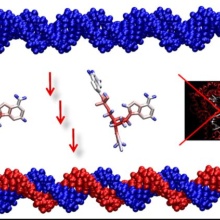The ability to pass on genetic information to later generations is a basic prerequisite for life. In nature, replication processes are catalyzed by enzymes. The cell replicates DNA, the carrier of the genetic information, prior to cell division using polymerase enzymes to ensure that each daughter cell receives the necessary genetic information. The research group headed by Professor Clemens Richert at the Institute of Organic Chemistry at the University of Stuttgart has now succeeded for the first time in conducting DNA replication processes without enzymes. In the study, the team gained insights into how passing on genetic information may have worked, or not worked, during very early stages of evolution.*)
For the experiments the scientists used chemically activated nucleotides, i.e. letters of the genetic alphabet equipped with easily detachable molecular parts. Nucleotides are the building blocks of DNA. These are molecules comprising sugar, phosphate and one of four different bases. In the experiments, nucleotides paired with the complementary base of the template strand and then reacted to form the copy of the sequence. The entire processes took place in the absence of enzymes. The genetic information of daughter strands produced in this way agreed with the sequence of the parental generation to various extents, and the replication process thus showed varying degrees of success.
Findings important for research work on the origins of life
Professor Clemens Richert explained that these findings are of importance for the origins of life: “Similar to the classical question: what came first, the chicken or the egg?‘ there is the question: ‘Did enzymes or replication come first?‘“ In the cell, enzymes are produced by reading genes, but genes cannot be read without enzymes. This appeared to mean: no replication without enzymes and no enzymes without replication. The results obtained by the Stuttgart researchers using their chemical model system now suggest that very early living systems may have been able to replicate genetic information without enzymes more easily than previously thought.
Early living systems may have used only two DNA bases
In their experiments, the team headed by Professor Richert measured how faithfully the genetic information was passed on during enzyme-free replication. The four bases of present-day DNA are guanine, cytosine, adenine and thymine. In the cell, guanine pairs with cytosine and adenine pairs with thymine. The results from the experiments now show that replications without enzymes occur with a modest level of errors when just guanine and cytosine are used. These two bases form strong pairs with three hydrogen bonds. In contrast, replication experiments including the weakly pairing bases adenine and thymine (two hydrogen bonds) proceeded with so many errors that the genetic information was quickly lost in what may be called “genetic noise”. If primitive living systems used similar reactions to replicate without enzymes, systems using just two bases may have functioned better than those with the four bases found in the genetic alphabet today.
Expertise at the Institute of Organic Chemistry
The know-how of the research group performing the experiments recently led to a major grant for a joint international project entitled “Molecular Life“ with Vanderbilt University and the Université Lyon 1 that is funded by the Volkswagen Foundation with more than one million Euros.
The experimental breakthrough described above also led to funding by the Deutsche Forschungsgemeinschaft (DFG) through the Collaborative Research Centre TRR 235 entitled “Emergence of Life - Exploring mechanisms with cross-disciplinary experiments“ (TRR SFB 235), coordinated by the Ludwig Maximilian University of Munich and the Technical University of Munich.
*) Original publication:
Enzyme-Free Replication with Two or Four Bases, M. Sc. Elena Hänle, Professor Clemens Richert, Angew. Chem. Int. Ed. 2018, published online on 19.06.2018, https://doi.org/10.1002/anie.201803074.
Caption: The sequence of bases that are contained in a DNA strand has been replicated without enzymes for the first time. Chemical building blocks that were used for this are shown next to the reaction arrows. Diagram: IOC
Expert Contact:
Professor Clemens Richert, Institute of Organic Chemistry at the University of Stuttgart, 0711/685-64311, email

Jacqueline Gehrke
Online Editor

Manfred Ehresmann
M.Sc.Systemsengineer and Research Assistant


